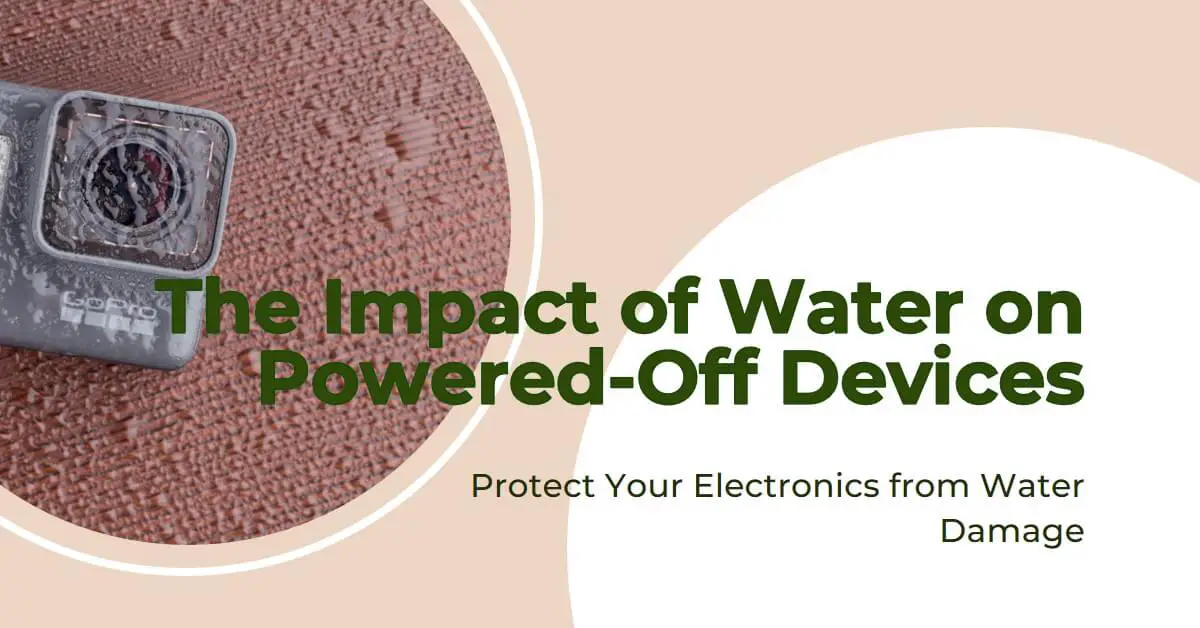Image: “Article Feature Image” by Bing, Source: [Bing Graphic Art].
Electronics have become an integral part of our daily lives, but they are vulnerable to various risks, including water damage.
Many people wonder whether their electronics can be affected by water even when they are turned off. The short answer is yes, water can indeed damage electronics that are off. Electronics, even when powered off, can still retain residual electrical charges and are susceptible to damage if water enters their internal components
In this article, we will explore the impact of water damage on electronics, factors affecting the damage, preventive measures, and steps to take if your devices come into contact with water.
Understanding Water Damage
Definition and Causes of Water Damage
Water damage occurs when liquid comes into contact with electronic devices, potentially causing harm to their internal components and functionality.
Common causes of water damage include accidental spills, exposure to rain or moisture, immersion in water, and high humidity levels.
Impact of Water on Electronics
Water can have several detrimental effects on electronics, even when they are turned off. These effects include short circuits and electrical damage, corrosion and oxidation, permanent data loss, and damage to components and internal circuitry.
The Effects of Water on Electronics
Short Circuits and Electrical Damage
When water enters an electronic device, it can create unintended paths for electrical current, leading to short circuits and damaging the delicate circuitry.
Even a small amount of water can disrupt the flow of electricity and cause irreparable harm.
Corrosion and Oxidation
Water contains impurities that can cause corrosion and oxidation on the electronic components.
Corrosion leads to the deterioration of metal contacts, connectors, and circuit boards, compromising the device’s functionality and potentially rendering it inoperable.
Permanent Data Loss
Water damage can result in the loss of valuable data stored on devices such as smartphones, laptops, or external hard drives.
Moisture can corrupt or destroy storage media, making data recovery extremely difficult or impossible.
Impact on Components and Internal Circuitry
Water can seep into various parts of an electronic device, damaging critical components such as processors, memory modules, and integrated circuits.
It can also cause swelling or warping of circuit boards, further jeopardizing the device’s functionality.
Factors Affecting Water Damage
Water Type and Conductivity
The type of water that comes into contact with electronics plays a role in the severity of the damage.
Pure water conducts less electricity, while impure water or liquids with additives can increase the conductivity, amplifying the risks.
Exposure Duration
The longer the exposure to water, the higher the chances of significant damage. Even a brief encounter with water can have detrimental effects, but prolonged exposure increases the likelihood of irreversible harm.
Moisture and Humidity Levels
High humidity levels can introduce moisture into electronic devices, leading to gradual damage over time. It is important to protect electronics from humid environments to mitigate the risks of water damage.
Depth of Immersion
Complete immersion of an electronic device in water poses a higher risk of severe damage compared to surface-level exposure.
The deeper the immersion, the more likely the water will penetrate and harm critical components.
The Off State: Myth or Protection?
How Electronics Are Affected When Turned Off
Contrary to popular belief, turning off electronics does not provide complete protection against water damage.
Even when powered off, electronic devices can still retain a residual electrical charge, making them susceptible to damage if water enters their internal components.
Standby Mode and Vulnerability
Devices in standby mode are particularly vulnerable to water damage. Standby mode keeps certain circuits active to respond to remote commands or perform background tasks, increasing the chances of electrical shorts and damage in the presence of water.
Unexpected Power Surges and Water Damage
Water contact can cause unexpected power surges when the device is turned on, resulting in immediate damage. These power
surges can occur even after the device has been powered off and then turned back on.
Steps to Take After Water Exposure
Removing Power Sources
If your device comes into contact with water, the first step is to disconnect all power sources, including unplugging the device from the electrical outlet and removing the batteries. This minimizes the risk of electrical damage and short circuits.
Drying Techniques and the Importance of Patience
After removing the power sources, dry the device gently using a soft cloth or towel. Avoid using heat sources like hairdryers, as they can cause further damage.
Patience is key during the drying process, as rushing can result in incomplete drying or damage.
Professional Assistance and Repair Services
In cases of extensive water damage or if you are unsure about handling the situation yourself, it is advisable to seek professional assistance.
Certified technicians can assess the damage, perform necessary repairs, and increase the chances of salvaging the device.
Read also my article: Reviving Wet Electronics: Can They Bounce Back?
Disclaimer: This contains affiliate links to Amazon products. I may earn a commission for purchases made through these links.
Preventive Measures
Waterproofing and Protective Cases
Investing in waterproof cases or covers for your electronics, especially for smartphones and tablets, can provide an additional layer of protection against water damage. These cases help seal out water and reduce the risk of liquid intrusion.
Safe Usage and Handling Tips
Avoid using electronic devices near water sources or in humid environments whenever possible. Be cautious with liquids around electronics and ensure that your hands are dry when handling devices, particularly when plugging or unplugging cables.
Avoiding High-Risk Environments
Keep electronics away from areas prone to water exposure, such as bathrooms, kitchens, and swimming pools.
Also, be mindful of taking devices outdoors in inclement weather conditions, where they may be exposed to rain or splashes.
Regular Maintenance and Inspections
Performing routine maintenance checks, such as cleaning ports and connectors, can help prevent water damage.
Regular inspections allow you to identify potential issues early on and take necessary precautions to protect your devices.
For more information read also my article: The Hidden Dangers: How Water Can Ruin Your Electronics.
Insurance and Warranty Considerations
Water Damage Coverage in Electronics Insurance
Review your electronics insurance policy to understand the coverage provided for water damage. Some insurance plans may offer specific protection against accidental liquid damage, providing financial assistance for repairs or replacements.
Manufacturer Warranties and Water Damage
Check the terms and conditions of the manufacturer’s warranty. Some warranties may cover water damage, while others specifically exclude it.
Understanding warranty coverage helps you make informed decisions regarding repairs and replacements.
Conclusion
Water damage poses a significant risk to electronic devices, even when they are turned off. Water can cause short circuits, corrosion, permanent data loss, and damage to internal components.
By understanding the effects of water damage and implementing preventive measures, such as waterproofing, safe usage practices, and regular maintenance, you can reduce the chances of water-related incidents and prolong the lifespan of your electronics.
If water damage does occur, it is crucial to act promptly by disconnecting power sources, drying the device, and seeking professional assistance if necessary. By taking these steps, you can protect your electronics and ensure their longevity.

